A Cross-Sectional Review of Blockchain in Thailand: Research Literature, Education Courses, and Industry Projects
Abstract
:1. Introduction and Background
2. Methodology
- Identify objectives for the review as well as develop a protocol for data retrieval and analysis;
- Locate data, select the data, and summarize data into a table; and
- Report the results of the reviews.
2.1. Locating Data
2.1.1. Locating Data for Literature Reviews of Blockchain Research in Thailand
2.1.2. Locating Data for Literature Reviews of Blockchain Projects and Courses in Thailand
- Top 200 search results from Google were retrieved and recorded to prevent the change of search results due to search engine’s algorithm.
- (a)
- On 9 December 2020, the results about projects were collected with three Thai words “โครงการ บล็อกเชน ประเทศไทย [Thailand blockchain projects]” as a search term.
- (b)
- On 13 January 2021, data of blockchain courses in Thailand were collected with the following search pattern: “บล็อกเชน [blockchain] OR blockchain OR block chain OR บิทคอยน์ [bitcoin] OR bitcoin OR ethereum OR Cryptocurrency OR fintech AND หลักสูตร [course] OR สอน [teaching] OR บรรยาย [lecture] OR สัมมนา [seminar] OR วิชา [subject] OR อบรม [training].”
- A further search using keywords found in the contents of search results from the previous step (snowball method) was carried out to make the search scope more inclusive and detailed. Since search results in the first step were likely to be general, such as articles about blockchain concept, press releases showing a project progress, course advertisements, and news about courses, the details of projects retrieved in the previous step might not be adequate for analysis. The keywords could be a term relevant to either blockchain-oriented projects or courses, such as titles, stakeholders, and architectures.
2.2. Selection and Evaluation
2.3. Analysis
3. A Systematic Review of Blockchain Research in Thailand
3.1. Trend of Blockchain Research in Thailand
3.2. Focus of Blockchain Research in Thailand
3.3. Characteristics of Blockchain Research in Thailand
- Framework of blockchain applicationResearch that presented frameworks of blockchain applications was found the most in the blockchain research in Thailand. This was a direct approach of blockchain research. However, most of the articles explained only featured characteristics of blockchain, such as decentralization, transparency, and high velocity. After that, they explained how these characteristics could solve problems of traditional systems in their domains. Some articles further presented frameworks with visualization showing the relation between stakeholders in networks. Some articles explained only how a blockchain system works in detail, but essential technical information for implementation was not found in this group of presentation. Thus, the objective of this group of articles mostly was business-oriented. Few articles presented a focus on technology development, but they had insufficient information for system implementation.
- Blockchain implementation guidelinesSimilar to the framework group of articles, this approach was a direct blockchain research. Articles in this group especially presented their architectures together with the software and types of blockchain they used. It was, thereby, possible to follow the proposed steps for an actual implementation. The group’s aim was technology development rather than business. However, only few articles in Thailand included technical performance evaluation section, such as speed and security. Most of the articles only presented a framework with a prototype test.
- Adoption of blockchainThis was an indirect approach of blockchain research. Examples of blockchain research papers in the adoption group are the following. An article studied about behavioral factors of stakeholders in a successful blockchain implementation in collaborative projects. Another article studied applications of products with blockchain as an infrastructure, such as, evaluating Bitcoin’s performance in investment. Because this group of presentation did not deliver blockchain research directly, the focuses of these articles were mostly business application or other objectives apart from blockchain development. This group of presentation had the least number of research.
4. A Review of Blockchain Courses in Thailand
4.1. Trends of Blockchain Courses in Thailand
4.1.1. A Trend of the Number of Blockchain Courses in Thailand
4.1.2. A Trend of Instructional Mode from 2016 to 2020
4.2. Focus of Blockchain Courses in Thailand
4.3. Characteristics of Blockchain Courses in Thailand
4.3.1. Distribution of Blockchain Courses in Thailand by Duration
4.3.2. Distribution of Blockchain Courses in Thailand by Instructors
5. A Review of Blockchain Projects in Thailand
5.1. Trend of Blockchain Projects in Thailand
5.2. Focus of Blockchain Projects in Thailand
5.3. Characteristics of Blockchain Project Implementation in Thailand
5.4. Generations of Blockchain and Blockchain Projects in Thailand
6. Discussion
6.1. Timeline and Trends
6.2. Cross-Sectional Domains
6.3. Opportunities and Challenges
- StakeholdersBlockchain is considered a new technology, even in the academic sphere. Hence, it was likely that the rejection of the technology could happen from the stakeholders with limited understanding and exposure to blockchain. For instance, few fishermen, who were interviewed for a study of blockchain application in Thailand fishery, “seemed to be reluctant in providing direct answers about the fishing methods and records” [21]. The transparency characteristics that blockchain holds could cause a resistance when collecting the data. Thus, with the slow adaptation and negative attitudes towards blockchain, it could be a challenge from stakeholders during the process of data collection for blockchain research and project implementation.
- Traditional system integrationA lot of blockchain studies and projects presents blockchain as a solution for a centralized system with intermediary and errors in systems caused by human’s mistakes. Nevertheless, the traditional system could not be replaced completely. For example, the result announcement of lottery system had to remain the traditional way and changing it was difficult [15]; voters had to go to voting sites for authentication before casting the vote on a blockchain-based platform [17]; and energy trading on blockchain platform still relied on government policies to support energy trading in every form [26]. It shows that blockchain applications were obstructed by the traditional approaches. Therefore, blockchain research could not be proved in respect to the abilities to deal with the middleman problems and could not show a decentralized system clearly.
- Policies and regulationsMost of blockchain studies found outdated policies as an obstacle when planning to implement blockchain prototypes. For instance, blockchain might not disrupt some services of Department of Lands of Thailand because the services were governed by laws [16]. Moreover, current policies do not endorse the collaboration between the people who are interested in blockchain applications. Rungkaputi [23], for example, suggested that the authorities should develop specific accounting guidelines for SMEs in the financial industry. A challenge from policies and regulations today can be considered not only the challenge for blockchain application, but also a challenge for blockchain research in the implementation step.
6.4. Threats to Validity
7. Conclusions and Future Directions
- Promote graduate-level or long-term professional courses about blockchain;
- Promote studies in more diverse research focuses and research areas as well as initiate research of Blockchain 4.0 in Thailand;
- Promote adoption of local research works into practical projects.
Author Contributions
Funding
Acknowledgments
Conflicts of Interest
References
- Digital Government Development Agency (DGA). Blockchain for Government Services การใช้เทคโนโลยีบล็อกเชนสำหรับภาครัฐ [How to use Blockchain for Government Services]. 2019. Available online: https://www.dga.or.th/ (accessed on 2 December 2020).
- Bitcoin. Available online: https://bitcoin.org/en/ (accessed on 8 March 2021).
- Ethereum. Available online: https://ethereum.org/en/ (accessed on 8 March 2021).
- MultiChain. Available online: https://www.multichain.com/ (accessed on 8 March 2021).
- Hyperledger. Available online: https://www.hyperledger.org/ (accessed on 8 March 2021).
- Corda. Available online: https://www.corda.net/ (accessed on 8 March 2021).
- Blognone. กรุงศรีและไออาร์พีซี ประกาศความสำเร็จในการโอนเงินระหว่างประเทศผ่าน นวัตกรรม Krungsri Blockchain’s Interledger แบบเรียลไทม์เป็นครั้งแรกของภาคธุรกิจไทย [Krunsri and IRPC Announce the Success in Real-Time International Transfer Innovation, Called Krungsri Blockchain’s Interledger, for the First Time in Thai Business Sector]. 2017. Available online: https://www.blognone.com/node/95752 (accessed on 18 December 2020).
- Bank of Thailand. การเชื่อมโยงระบบการชำระเงินในอาเซียน (ASEAN Payment Connectivity) ณ การประชุม ASEAN Central Bank Governors วันที่ 4 เมษายน 2562 จ.เชียงราย [ASEAN Payment Connectivity on the ASEAN Central Bank Governors conference in Chiangrai on April 4th, 2019]. 2019. Available online: https://www.bot.or.th/Thai/PressandSpeeches/Press/News2562/n2062t.pdf (accessed on 14 December 2020).
- Techsauce Team. ธนาคารไทยพาณิชย์เปิดตัวบริการโอนเงินข้ามปร ะเทศผ่าน Blockchain ครั้งแรกในไทยแล้ว [SCB has Launched an International Money Transfer Service on Blockchain for the First Time in Thailand]. 2017. Available online: https://techsauce.co/news/scb-ripple-launch-first-blockchain-powered-payment-service-between-japan-and-thailand (accessed on 27 December 2020).
- Bhumiratana, B. Thai-Blockchain-Ecosystem-Map. 2018. Available online: https://github.com/bhume/thai-blockchain-ecosystem-map (accessed on 16 March 2021).
- Casino, F.; Dasaklis, T.K.; Patsakis, C. A systematic literature review of blockchain-based applications: Current status, classification and open issues. Telemat. Inform. 2019, 36, 55–81. [Google Scholar] [CrossRef]
- Leible, S.; Schlager, S.; Schubotz, M.; Gipp, B. A review on blockchain technology and blockchain projects fostering open science. Front. Blockchain 2019, 2, 16. [Google Scholar] [CrossRef]
- Themistocleous, M.; Christodoulou, K.; Iosif, E.; Louca, S.; Tseas, D. Blockchain in Academia: Where do We Stand and Where Do We Go? HICSS: Maui, HI, USA, 2020; pp. 1–10. [Google Scholar]
- Chalaemwongwan, N.; Kurutach, W. A practical national digital ID framework on blockchain (NIDBC). In Proceedings of the 2018 15th International Conference on Electrical Engineering/Electronics, Computer, Telecommunications and Information Technology (ECTI-CON), Chiang Rai, Thailand, 18–21 July 2018; pp. 497–500. [Google Scholar]
- Saichua, P.; Khunthi, S.; Chomsiri, T. Design of Blockchain Lottery for Thai Government. In Proceedings of the 2019 Joint International Conference on Digital Arts, Media and Technology with ECTI Northern Section Conference on Electrical, Electronics, Computer and Telecommunications Engineering (ECTI DAMT-NCON), Nan, Thailand, 30 January–2 February 2019; pp. 9–12. [Google Scholar]
- Pongnumkul, S.; Khonnasee, C.; Lertpattanasak, S.; Polprasert, C. Proof-of-Concept (PoC) of Land Mortgaging Process in Blockchain-based Land Registration System of Thailand. In Proceedings of the 2020 The 2nd International Conference on Blockchain Technology, Rhodes Island, Greece, 2–6 November 2020; pp. 100–104. [Google Scholar]
- Wisessing, K.; Ekthammabordee, P.; Surasak, T.; Huang, S.C.H.; Preuksakarn, C. The Prototype of Thai Blockchain-Based Voting System. IJACSA 2020, 11, 5. [Google Scholar] [CrossRef]
- Surasak, T.; Wattanavichean, N.; Preuksakarn, C.; Huang, S.C.H. Thai agriculture products traceability system using blockchain and internet of things. IJACSA 2019, 10, 9. [Google Scholar] [CrossRef]
- Jintapitak, M.; Ansari, M.A.; Kamyod, C.; Singkhamfu, W.; Kamthe, N.S.; Temdee, P. Blockchain Eco-System for Thai Insect Industry: A Smart Contract Conceptual Framework. In Proceedings of the 2019 22nd International Symposium on Wireless Personal Multimedia Communications (WPMC), Lisbon, Portugal, 24–27 November 2019; pp. 1–4. [Google Scholar]
- Supranee, S.; Rotchanakitumnuai, S. The acceptance of the application of blockchain technology in the supply chain process of the Thai automotive industry. In Proceedings of the International Conference on Electronic Business (ICEB), Dubai, United Arab Emirates, 4–8 December 2017; Volume 2017, pp. 252–257. [Google Scholar]
- Tsolakis, N.; Niedenzu, D.; Simonetto, M.; Dora, M.; Kumar, M. Supply network design to address United Nations Sustainable Development Goals: A case study of blockchain implementation in Thai fish industry. J. Bus. Res. 2021, 131, 495–519. [Google Scholar] [CrossRef]
- Chaveesuk, S.; Khalid, B.; Chaiyasoonthorn, W. Understanding Stakeholders Needs for Using Blockchain Based Smart Contracts in Construction Industry of Thailand: Extended TAM Framework. In Proceedings of the 2020 13th International Conference on Human System Interaction (HSI), Tokyo, Japan, 6–8 June 2020; pp. 137–141. [Google Scholar]
- Rungkaputi, C. The development of accounting verification process affecting digital currency transactions using blockchain technology for small and medium business in Thailand. Eurasian J. Anal. Chem. 2018, 13, 315–320. [Google Scholar]
- Pinudom, B.; Tungpisansampun, W.; Tansuchat, R.; Maneejuk, P. Could Bitcoin enhance the portfolio performance? In Journal of Physics: Conference Series; IOP Publishing: Bristol, UK, 2018; Volume 1053, p. 012113. [Google Scholar]
- Thampanya, N.; Nasir, M.A.; Huynh, T.L.D. Asymmetric correlation and hedging effectiveness of gold & cryptocurrencies: From pre-industrial to the 4th industrial revolution. Technol. Forecast. Soc. Chang. 2020, 159, 120195. [Google Scholar]
- Leelasantitham, A. A Business Model Guideline of Electricity Utility Systems Based on Blockchain Technology in Thailand: A Case Study of Consumers, Prosumers and SMEs. Wirel. Pers. Commun. 2020, 115, 3123–3136. [Google Scholar] [CrossRef]
- Processing Center Co., Ltd. PCC จัดงานสัมมนา “Block Chain & Open API” ณ โรมแรม BOTANICA KHAO YAI [PCC hold a Seminar on “Blockchain & Open API” at Botanica Khao Yai Hotel]. Available online: https://www.pcc.co.th/jpcc/index.php/news/50-botanica (accessed on 13 January 2020).
- พจนันท์ รัตนไชยพันธ์ [Photchanan Ratanajaipan]. สัมมนา “เทคโนโลยี BLOCK CHAIN กับความเปลี่ยนแปลงในการให้บริการทางกฎหมาย” [Seminar on the Topic of “Blockchain Technology and the Changes in Legal Services”]. 2020. Available online: https://www.thnic.or.th/blockchain-tu/ (accessed on 13 January 2020).
- NIDA. FinTech and Blockchain for Digital Transformation. Available online: http://as.nida.ac.th/gsas/event/fintech-and-blockchain/ (accessed on 13 January 2020).
- การซื้อขายในตลาดเงินดิจิทัลและรู้จักเทคโนโลยีบล็อก เชน [Trading in Digital Money Market and Getting to Know Blockchain]. Available online: https://www.skilllane.com/courses/cryptocurrency-blockchain-technology (accessed on 13 January 2020).
- IMC Institute. Blockchain Concept & Practical Use Case for Management. Available online: https://docs.google.com/document/d/11oY2JehunTBkWE7T0GAoV1K3DqO7fCILknQCrMC41yg/edit (accessed on 13 January 2020).
- ปูพื้นฐานสร้างความเข้าใจกับ Blockchain & Bitcoin 101 (Beginner Course) by Bitkub Academy. 2020. Available online: https://www.eventpop.me/e/8206 (accessed on 13 January 2020).
- ปูพื้นฐานสร้างความเข้าใจกับ Blockchain & Bitcoin 101 ครั้งที่ 2 (2nd). 2020. Available online: https://www.eventpop.me/e/9452?aff=siamblockchain (accessed on 13 January 2020).
- ปูพื้นฐานสร้างความเข้าใจกับ Blockchain & Bitcoin 101 ครั้งที่ 3 (3rd). 2020. Available online: https://www.eventpop.me/e/9838 (accessed on 13 January 2020).
- Australian Alumni Association Thailand. การอบรม/สัมมนาเชิงปฏิบัติการ เรื่อง รู้ทันเทคโนโลยี Blockchain: The Next Internet? [Blockchain: The Next Internet?“: A Workshop to Get to Know Blockchain Technology]. 2017. Available online: https://tatsc.or.th/index.php/events/181-blockchain-the-next-internet (accessed on 13 January 2020).
- Australian Alumni Association Thailand. การอบรม/สัมมนาเชิงปฏิบัติการ เรื่อง รู้ทันเทคโนโลยี Blockchain: The Next Internet? รุ่นที่ 2 [Blockchain: The Next Internet?”: The 2nd Workshop to Get to Know Blockchain Technology]. 2017. Available online: https://www.ubu.ac.th/web/files/29n2017111411230948.pdf (accessed on 13 January 2020).
- Australian Alumni Association Thailand. การอบรม/สัมมนาเชิงปฏิบัติการ เรื่อง รู้ทันเทคโนโลยี Blockchain: The Next Internet? รุ่นที่ 3 [Blockchain: The Next Internet?”: The 3rd Workshop to Get to Know Blockchain Technology]. 2018. Available online: https://www.tatsc.or.th/index.php/events/188-blockchain-the-next-internet-3-4-6-2561 (accessed on 13 January 2020).
- Australian Alumni Association Thailand. การอบรม/สัมมนาเชิงปฏิบัติการ เรื่อง รู้ทันเทคโนโลยี Blockchain: The Next Internet? รุ่นที่ 4 [Blockchain: The Next Internet?”: The 4th Workshop to Get to Know Blockchain Technology]. 2018. Available online: https://www.tatsc.or.th/index.php/events/197-blockchain-the-next-internet-4-12-14-2561 (accessed on 13 January 2020).
- TechTalkThai. ม.ธุรกิจบัณฑิตย์จับมือ KBank เปิดหลักสูตรสอนเขียนโปรแกรม Blockchain เรียนกับผู้เชี่ยวชาญโดยตรง สมัครได้แล้ววันนี้ [Dhurakij Pundit U. in Collaboration with Kbank Launches a New Course for Blockchain Development with Experts Directly. Register Now]. 2018. Available online: https://www.techtalkthai.com/geeks-on-the-blockchain-course-by-dpu-kbank-and-smartcontract-thailand/ (accessed on 13 January 2020).
- Techsauce Team. กสิกรไทยจับมือ IBM นำ Blockchain มาใช้กับ Smart Contract [Kbank in Collaboration with IBM Applies Blockchain with Smart Contract]. 2016. Available online: https://techsauce.co/news/kasikorn-partners-with-ibm-for-blockchain-technology (accessed on 25 December 2020).
- ปิยพร อรุณเกรียงไกร [Piyaporn Arunkriangklai]. ทำไมกสิกรไทยถึงเปิดบริการ ‘หนังสือค้ำประกันบนบล็อกเชน’ รายแรกของโลก? [Why is Kbank the First One in the World to Launch Letter of Guarantee Service on Blockchain?]. 2017. Available online: https://thestandard.co/news-business-kasikorn-bank-ibm-blockchain/ (accessed on 25 December 2020).
- Department of Intellectual Property, Ministry of Commerce. บทวิเคราะห์แนวโน้มเทคโนโลยีบล็อกเชนเพื่ออุตสาหกรรมแห่งอนาคต [Analysis on the Tendency of Blockchain Technology for Future Industries]. 2019. Available online: http://ipthailand.go.th/images/2284/BlockchainAnalysis2019.pdf (accessed on 25 December 2020).
- Techsauce Team. SCB ร่วมลงทุนใน Ripple ผู้นำด้านการพัฒนาเทคโนโลยี Blockchain พร้อมศึกษาและทดลองระบบโอนเงินระหว่างประเทศ รูปแบบใหม่แห่งอนาคตเป็นรายแรกในไทย [SCB has Invested in Ripple, a Leading Company in Blockchain Development, and is the First One in Thailand to Research and Test the New Promising Way of International Transfer System]. 2016. Available online: https://techsauce.co/fintech/scb-digitalventures-ripple/ (accessed on 27 December 2020).
- Prachachat Business. 14 แบงก์ไทย 7 องค์กร เร่งใช้บล็อกเชน ทำหนังสือคำประกัน (L/G) [14 Thai Banks and 7 Organizations Hurriedly Applied Blockchain for Letter of Guarantee Service (L/G)]. 2018. Available online: https://www.prachachat.net/finance/news-132232 (accessed on 9 December 2020).
- Techsauce Team. BCI จับมือ IBM ยกระดับจดหมายค้ำประกันอิเล็กท รอนิกส์ ต่อยอดบริการทางการเงินบน Blockchain [BCI in Collaboration with IBM Improves Electronic Letter of Guarantee in Financial Services on Blockchain]. 2020. Available online: https://techsauce.co/pr-news/ibm-and-the-blockchain-community-initiative (accessed on 9 December 2020).
- Blognone. กลุ่มธนาคารไทยร่วมตั้งบริษัท BCI ยื่นหนังสือค้ำประกันผ่านบล็อคเชนครั้งแรกของโลก, เริ่มใช้จริงไตรมาสสามปีนี้ [Thai Bank0s Founds a Company, call BCI, Launching a Blockchain Service of Letter of Guarantee First Time in the World Officially Available in this Q3]. 2019. Available online: https://www.blognone.com/node/110004 (accessed on 9 December 2020).
- BCI. E-LG (Electronic Letter of Guarantee) On Blockchain. Available online: https://en.bci.network/products (accessed on 9 December 2020).
- IBM. BCI in Collaboration with IBM Advances Blockchain based Financial Services with Electronic Letter of Guarantee for Clients in Thailand. 2020. Available online: https://newsroom.ibm.com/2020-09-30-BCI-in-Collaboration-with-IBM-Advances-Blockchain-based-Financial-Services-with-Electronic-Letter-of-Guarantee-for-Clients-in-Thailand (accessed on 9 December 2020).
- Royal Thai Government. กรมบัญชีกลางต่อยอด e-GP ด้วยเทคโนโลยี Blockchain มุ่งยกระดับการให้บริการภาครัฐ [The Controller General Department Enhances e-GP Capacity with Blockchain Technology to Elevate Government Services’ Performance]. Available online: https://www.thaigov.go.th/news/contents/details/24684 (accessed on 9 December 2020).
- Royal Thai Government. ระบบ e-GP เริ่มออกหนังสือรับรองสินเชื่อ e-Credit Confirmation ด้วยเทคโนโลยี Blockchain 1 ม.ค. 63 [e-GP System Starts Launching e-Credit confirmation Service under Blockchain on Jan 1st, 2020]. Available online: https://www.thaigov.go.th/news/contents/details/25465 (accessed on 9 December 2020).
- Techsauce Team. BCI หนุน กรมบัญชีกลาง เปิดบริการหนังสือค้ำประกันอิเล็กทรอนิกส์ หรือ e-LG ผ่าน Blockchain [BCI in Partnership with the Controller General Department Launches a Service of Electronic Letter of Guarantee or e-LG on Blockchain]. 2020. Available online: https://techsauce.co/news/bci-e-lg-blockchain-tech-letter-of-guarantee (accessed on 9 December 2020).
- Thairath Online. นำร่องใช้บล็อกเชน 3 โครงการ [To Pilot Blockchain Application in Three Projects]. 2019. Available online: https://www.thairath.co.th/news/business/market-business/1703968 (accessed on 9 December 2020).
- Infoquest. สรรพากร เปิดใช้ Blockchain คืนภาษีนักท่องเที่ยว [Revenue Department Starts Applying Blockchain for Tourist’ s Tax Refund]. 2020. Available online: https://www.infoquest.co.th/2020/2156 (accessed on 9 December 2020).
- Customs Department. กรมศุลกากรร่วมลงนามในบันทึกข้อตกลงการใช้เทคโนโลยีบล็อกเชน (Blockchain) เชื่อมโยงโมบายแอพพลิเคชั่นคืนภาษีนักท่องเที่ยวได้แม่นยำและรวดเร็ว [Customs Department has Signed MOU for Blockchain Application for a More Reliable and Faster Tourist’s Tax Refund Service on Moblie]. 2019. Available online: http://www.customs.go.th/data_files/a3fb4a62378921d0709dfae2f0505614.pdf (accessed on 9 December 2020).
- Customs Department. คลังนำร่องเปิดตัว 3 ดิจิทัลแพลตฟอร์มบนบล็อกเชนคืนภาษีนักท่องเที่ยวเริ่ม 28 พ.ย.นี้ [Customs Department Pilots 3 Blockchain Digital Platforms for Tourist’s Tax Refund]. 2019. Available online: https://www.mof.go.th/th/view/attachment/file/3134343632 (accessed on 9 December 2020).
- Revenue Department. กรมสรรพากรผนึกกำลังพันธมิตรพร้อมใช้เทคโนโลยี Blockchain คืนภาษีนักท่องเที่ยวประเทศแรกของโลก [Revenue Department and Alliances has Joined Forces to Apply Blockchain on Tourist’S tax Refund for the First Time in the World]. 2020. Available online: https://www.rd.go.th/publish/fileadmin/user_upload/news/news10_2563.pdf (accessed on 9 December 2020).
- Institute for Small and Medium Enterprises Development. บล็อกเชนเปลี่ยนโลกเอสเอ็มอีไทย [Blockchain Changes the World of Thai SMEs]. Available online: https://ismed.or.th/SPR211162.php (accessed on 9 December 2020).
- Excise Department. กรมสรรพสามิตจับมือกรุงไทยยกระดับบริการด้ านภาษีเร่งผลักดันบล็อกเชนคืนภาษีส่งออกน้ำมัน [Excise Department in Collaboration with Krungthai Bank Elevates Tax Services by Enforcing Tax Refund for Oil Export on Blockchain]. 2019. Available online: https://webdev.excise.go.th/act2560/index.php/suppress-news/20-dist-news/421-62 (accessed on 9 December 2020).
- Matichon Online. “สรรพสามิต” เตรียมดึง บล็อกเชน ใช้ตรวจสอบการคืนภาษีดึงอีก 2 กรมจัดเก็บเชื่อมระบบป้องกันเอกชนหนีภาษี-ลักลอบขนถ่ายน้ำมัน 3 โครงการ [Excise Department is Planning on Three Projects to apply Blockchain on Tax Refund Examination and Joins Databases with Other two Departments to Prevent Tax Evasion and Oil Smuggling from the Private]. 2020. Available online: https://www.matichon.co.th/news-monitor/news_2474768 (accessed on 9 December 2020).
- Post Today. สรรพสามิตดันบล็อกเชนคืนภาษีส่งออกน้ำมัน [Excise Department Promotes Blockchain in Tax Refund for Oil Export]. 2019. Available online: https://www.posttoday.com/finance-stock/news/606398 (accessed on 9 December 2020).
- Bank of Thailand. แถลงข่าวร่วมโครงการ Inthanon-LionRock และการดำเนินการในระยะต่อไป [A Public Statement on the Collaboration in Inthanon-LionRock Project and Plans in the Following Phases]. 2020. Available online: https://www.bot.or.th/Thai/FinancialMarkets/ProjectInthanon/Pages/Inthanon_LionRock.aspx (accessed on 8 December 2020).
- Bank of Thailand. โครงการอินทนนท์ [Inthanon Project]. Available online: https://www.bot.or.th/Thai/BOTMagazine/Pages/256203TheKnowledge_ProjectInthanon.aspx (accessed on 8 December 2020).
- Bank of Thailand. โครงการอินทนนท์ระยะที่ 1 และแผนการดำเนินโครงการในระยะถัดไป [Inthanon Project Phase I and Plans in the Following Phases]. 2019. Available online: https://www.bot.or.th/Thai/PressandSpeeches/Press/News2562/n562t.pdf (accessed on 8 December 2020).
- Bank of Thailand. โครงการอินทนนท์ระยะที่ 2 และแผนในระยะถัดไป [Inthanon Project Phase II and Plans in the Following Phases]. 2019. Available online: https://www.bot.or.th/Thai/PressandSpeeches/Press/News2562/n3962t.pdf (accessed on 8 December 2020).
- Bank of Thailand. Project Inthanon Phase I. Available online: https://www.bot.or.th/English/FinancialMarkets/ProjectInthanon/Documents/Inthanon_Phase1_Report.pdf (accessed on 8 December 2020).
- Blognone. แบงค์ชาติใช้ Corda ของ R3 พัฒนาระบบต้นแบบการโอนเงินระหว่างธนาคารในโครงการอินทนนท์ [Bank of Thailand Chooses R3’s Corda to Develop a Prototype of Money Transfer System among Banks in Inthanon Project]. 2018. Available online: https://www.blognone.com/node/104762 (accessed on 8 December 2020).
- Bank of Thailand. แถลงข่าวร่วมโครงการ Inthanon-LionRock และการดำเนินการในระยะต่อไป [A Public Statement on the Collaboration in Inthanon-LionRock Project and Plans in the Following Phases]. Available online: http://www.efinancethai.com/LastestNews/app.index.aspx?id=V3YxY1pmVDcxTDA9&year=29&month=9&lang=T&v=2018&security= (accessed on 14 December 2020).
- Bank of Thailand. Project Inthanon-LionRock. Available online: https://www.bot.or.th/English/FinancialMarkets/ProjectInthanon/Documents/Inthanon-LionRock.pdf (accessed on 14 December 2020).
- efinanceThai. ธปท.เผย ก.ย.นี้จะขยายขอบเขตการทดลอง CBDC กับ ธ.กลา งฮ่องกง [BOT Reveals that, in September, the Scope of the Study in CBDC Project with HKMA Will Be Expanded]. 2020. Available online: http://www.efinancethai.com/LastestNews/app.index.aspx?id=S3ZpRzlieWpoZ1E9&year=2020&month=7&lang=T&v=2018&security= (accessed on 14 December 2020).
- Bank of Thailand. ความสำเร็จในการจำหน่ายพันธบัตรออมทรัพ ย์ผ่านเทคโนโลยีบล็อกเชน[Success in Selling Saving Bond via Blockchain Technology]. 2020. Available online: https://www.bot.or.th/Thai/PressandSpeeches/Press/2020/Pages/n5963.aspx (accessed on 8 December 2020).
- Bank of Thailand. Project DLT Scripless Bond. Available online: https://www.bot.or.th/Thai/DebtSecurities/Documents/DLT%20Scripless%20Bond.pdf (accessed on 8 December 2020).
- Wiput. ธนาคารกรุงไทยจับมือกับ Everex (EVX) และ Shwe Bank ให้บริการโอนเงินข้ามประเทศ [Krungthai Bank in Collaboration with Everex (EVX) and Shwe Bank Provides International Transfer]. 2019. Available online: https://siamblockchain.com/2019/04/01/ktb-everex-join-money-transfer-thai-to-myanmar/ (accessed on 14 December 2020).
- National Digital ID. About NDID. Available online: https://www.ndid.co.th/about.html (accessed on 27 December 2020).
- efinanceThai. ธปท. ลุ้น ปลายปีนี้บริการเปิดบัญชีดิจิทัลข้าม แบงก์ผ่าน NDID เต็มรูปแบบ [BOT Expected that, by the End of this Year, Customers Can Fully Open a Digital Bank Account across Banks through NDID]. 2020. Available online: https://thestandard.co/bank-account-via-the-digital-ndid/ (accessed on 27 December 2020).
- Blognone. KBank ประกาศให้บริการหนังสือค้ำประกันออนไลน์ ผ่านบล็อคเชนทั้งหมด [Kbank Announced That all of their Letter of Guarantee Service are Operated under Blockchain System]. 2019. Available online: https://www.blognone.com/node/110590 (accessed on 14 December 2020).
- Infoquest. KBANK จับมือ ThaiBMA ออกหุ้นกู้ 17 ล้านยูโร ขายบนบล็อกเชนเป็นธนาคารแรกในไทย [Kbank in Collaboration with ThaiBMA is the First Bank in Thailand to Sell Debentures Worth 17M Euros on Blockchain]. 2020. Available online: https://www.infoquest.co.th/2020/23150 (accessed on 9 December 2020).
- Techsauce Team. Toyota Leasing ออกหุ้นกู้ด้วย Blockchain รายแรกในไทย ด้วยมูลค่า 500 ล้านบาททราบข้อมูลผู้ถือครองตราสารหนี้ Realtime [Toyota Leasing Sold Departures worth 500M on Blockchain for the First Time in Thailand. The Holders Could Be Identified in Real Time]. 2020. Available online: https://techsauce.co/news/toyota-leasing-blockchain (accessed on 9 December 2020).
- Marketeer. กสิกรไทยและวีซ่าร่วมโครงการนำร่องพัฒนาระบบ การชำระเงินระหว่างธุรกิจ ด้วยเทคโนโลยีบล็อกเชน [Kbank and VISA Pilot a Business-to-Business Payment System with Blockchain Technology]. 2018. Available online: https://marketeeronline.co/archives/75122 (accessed on 10 December 2020).
- Techsauce Team. VISA จับมือ KBank เปิดตัว ’VISA B2B Connect’ ระบบชำระเงินระหว่างภาคธุรกิจบน Blockchain [VISA in Collaboration with Kbank Launches a Business-to-Business Payment System on Blockchain, Called ‘VISA B2B Connect’]. 2018. Available online: https://techsauce.co/news/visa-and-kbank-launches-visa-b2b-connect-on-blockchain (accessed on 10 December 2020).
- Ledger Insights. ING Open Sources Advanced Blockchain Privacy Tech. 2019. Available online: https://www.ledgerinsights.com/ing-open-sources-advanced-blockchain-privacy-tech/ (accessed on 10 December 2020).
- BBC. A Game Changer for Cross-Border Payments. Available online: http://www.bbc.com/storyworks/future/the-new-rules-of-money/a-game-changer-for-cross-border-payments (accessed on 10 December 2020).
- Visa Inc. FIS Integrates into Visa B2B Connect Platform. 2019. Available online: https://usa.visa.com/about-visa/newsroom/press-releases.releaseId.16341.html (accessed on 10 December 2020).
- PR News. กรุงศรีเปิดบริการ Krungsri Blockchain Interledger โอนเงินผ่านเทคโนโลยีบล็อกเชนแบบเรียลไทม์จาก สปป.ลาว มายังประเทศไทย [Krungsri Launches a Real-Time Transfer from Laos to Thailand on Blockchain, called Krunsri Blockchain Interledger]. 2019. Available online: https://positioningmag.com/1253288 (accessed on 18 December 2020).
- Thairath Online. กรุงศรี นำร่องธุรกรรมเลตเตอร์ออฟเครดิต ระหว่างไทย-ญี่ปุ่นผ่าน Blockchain [Krungsri Pilots a Letter of Credit Service between Thailand and Japan on Blockchain]. 2020. Available online: https://www.thairath.co.th/news/business/finance-banking/1979896 (accessed on 27 December 2020).
- Techsauce Team. กรุงศรีและ IBM ประกาศความสำเร็จนำร่องใช้ Blockchain บริหารจัดการเอกสาร [Krungsri and IBM Succeeded in Piloting a Document Management on Blockchain]. 2017. Available online: https://techsauce.co/pr-news/krungsri-ibm-blockchain-technology (accessed on 27 December 2020).
- Customs Department. กรมศุลกากรร่วมมือกับไอบีเอ็มและเมอส์กนำเทคโนโลยีบล็อกเชนมาใช้เพื่อพัฒนาการค้าระหว่างป ระเทศของไทย (TradeLens Platform with Blockchain Technology) [Customs Department in Collaboration with IBM and Maersk uses Blockchain Techonology to Develop Thailand International Trading (TradeLens Platform with Blockchain Technology)]. 2019. Available online: http://www.customs.go.th/cont_strc_simple_with_date.php?lang=th&top_menu=menu_homepage&ini_menu=menu_public_relations_160421_04&left_menu=menu_public_relations_160421_04_160421_01¤t_id=142328324148505e4e464a4f464b47 (accessed on 19 December 2020).
- อริญชัย วีรดุษฎีนนท์ [Arinchai Weeraduthsadeenon]. กรมศุลกากรเปิดตัวแพลตฟอร์ม ’เทรดเลน ส์’ช่วยตรวจสินค้าละเมิดลิขสิทธิ์-เลี่ยงภาษีจากการขนส่งทางเรือ [Custom Department has Launched ‘TradeLens’ Platform to Detect Pirated Goods and Tax Evasion from Seafreight]. 2019. Available online: https://themomentum.co/thai-customs-tradelens/ (accessed on 19 December 2020).
- Blognone. IBM และกรมศุลกากร นำบล็อคเชนมาจัดการขนส่งสินค้าทางเรือ ยกระดับตรวจสินค้าผิดกฎหมาย [IBM and Customs Department Applies Blockchain to Detect Illegal Goods from Seafreight]. 2019. Available online: https://www.blognone.com/node/111605 (accessed on 19 December 2020).
- Yang, W.; Garg, S.; Raza, A.; Herbert, D.; Kang, B. Blockchain: Trends and future. In Pacific Rim Knowledge Acquisition Workshop; Springer: Berlin, Germany, 2018; pp. 201–210. [Google Scholar]
- Angelis, J.; da Silva, E.R. Blockchain adoption: A value driver perspective. Bus. Horizons 2019, 62, 307–314. [Google Scholar] [CrossRef]
- Mukherjee, P.; Pradhan, C. Blockchain 1.0 to Blockchain 4.0—The Evolutionary Transformation of Blockchain Technology. Blockchain Technol. Appl. Chall. 2021, 29–49. [Google Scholar] [CrossRef]
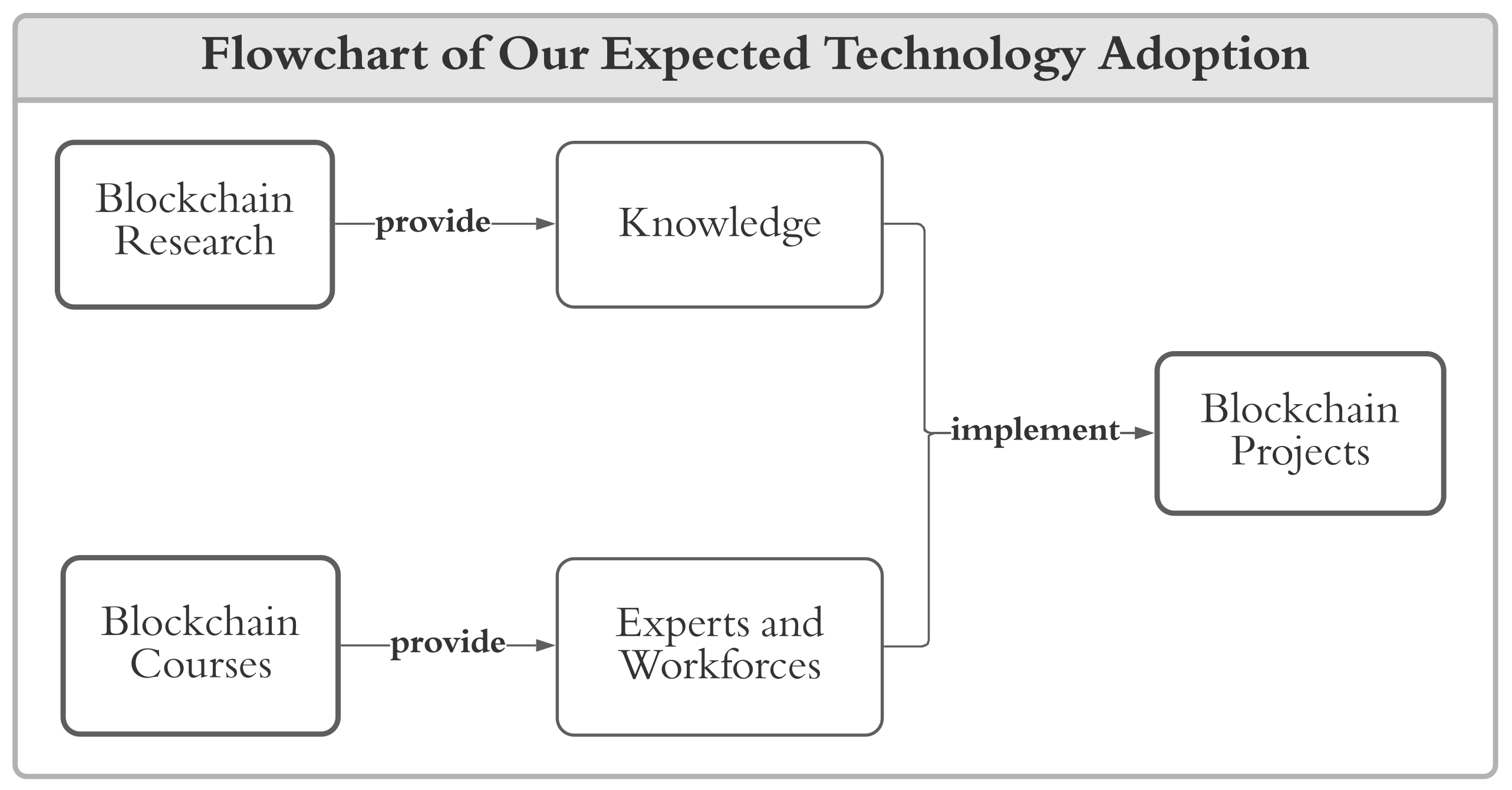
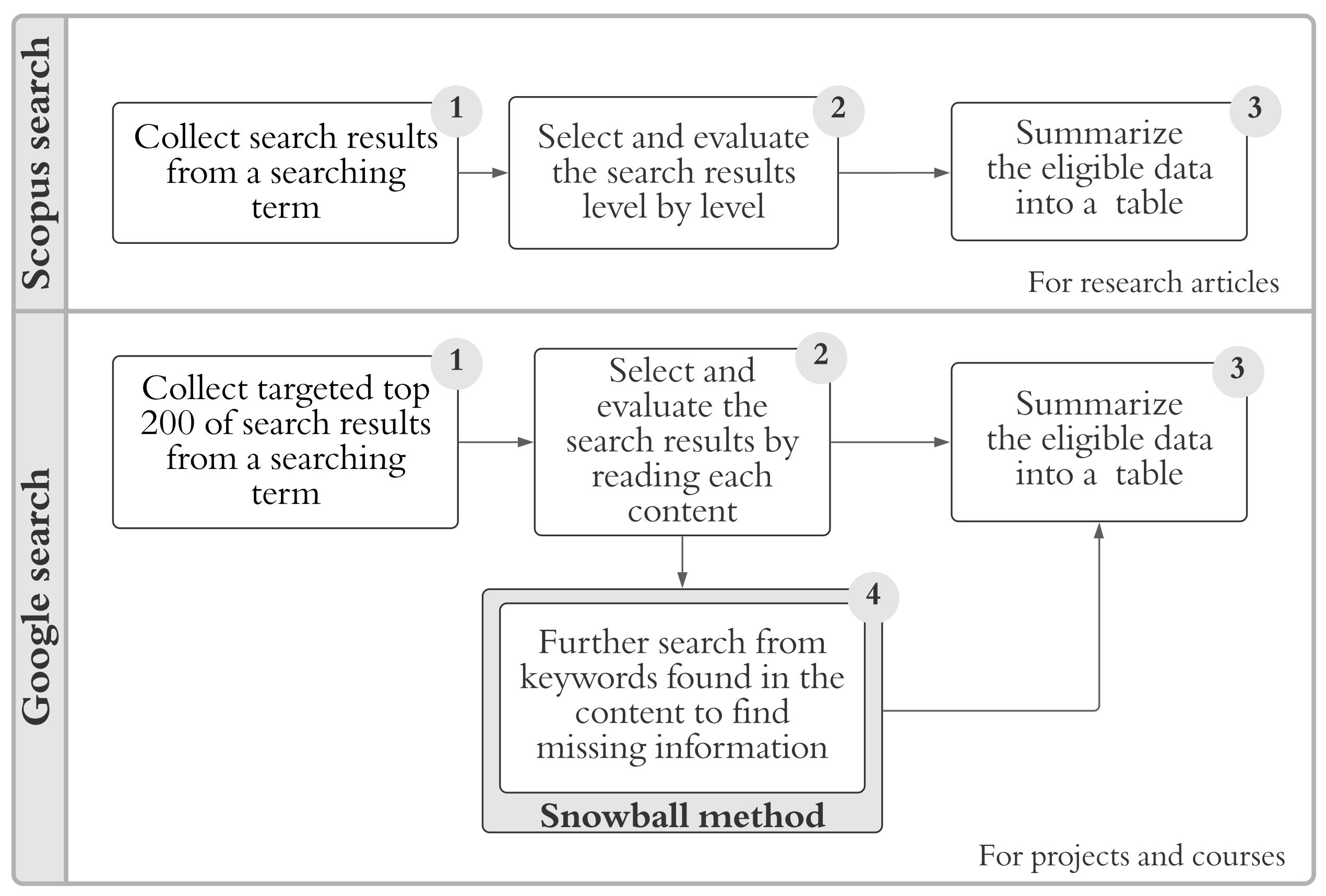

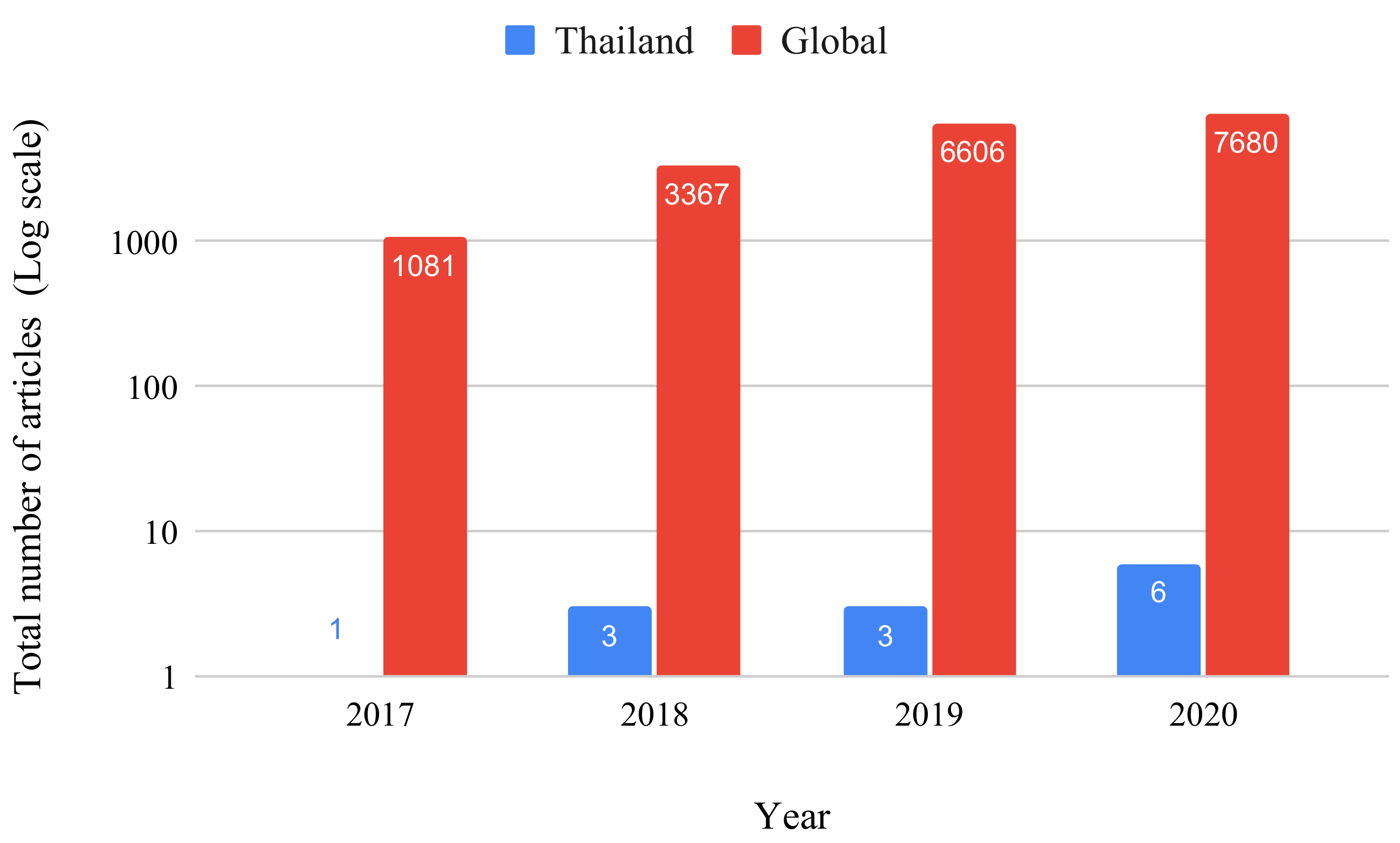
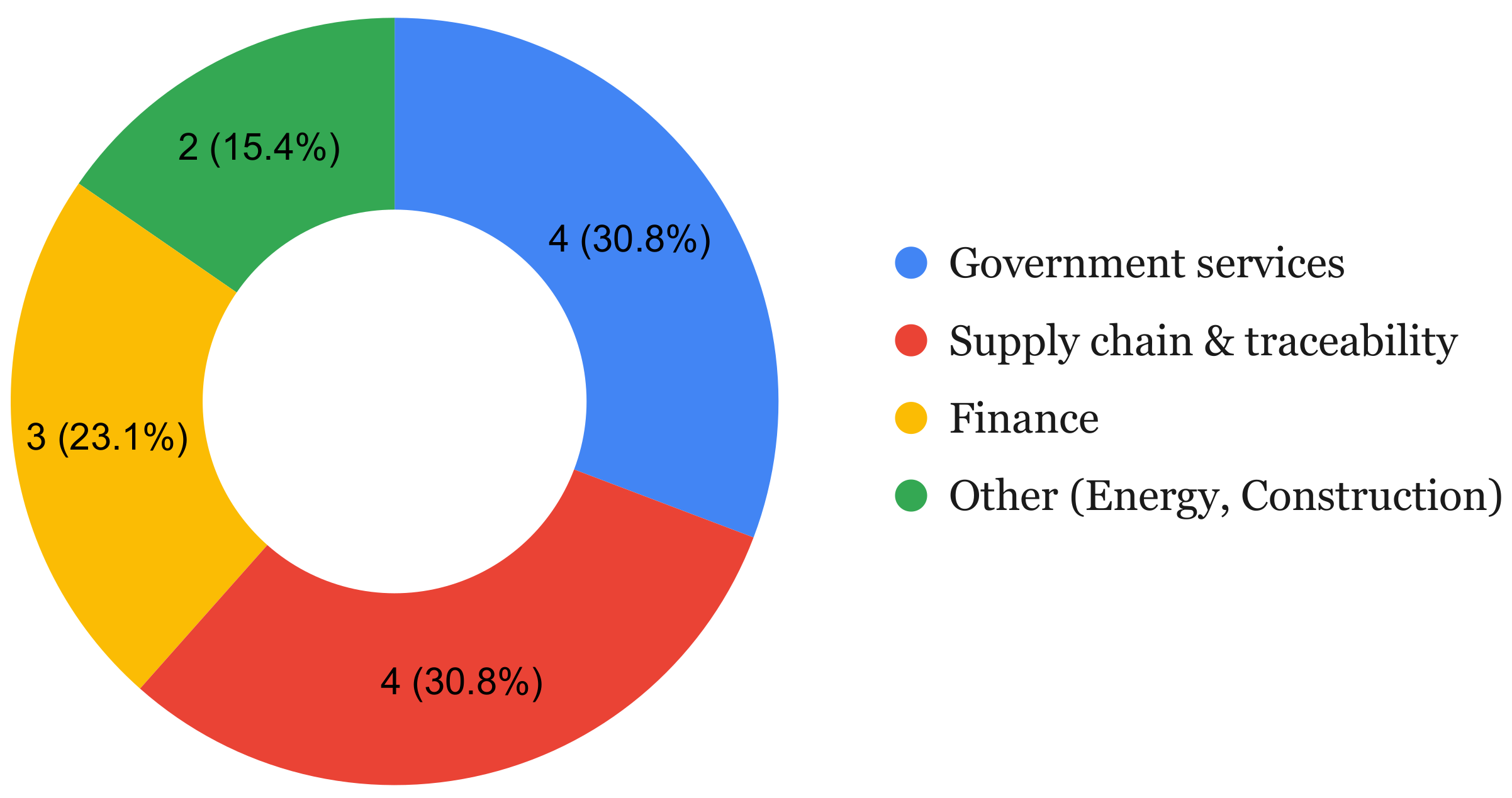
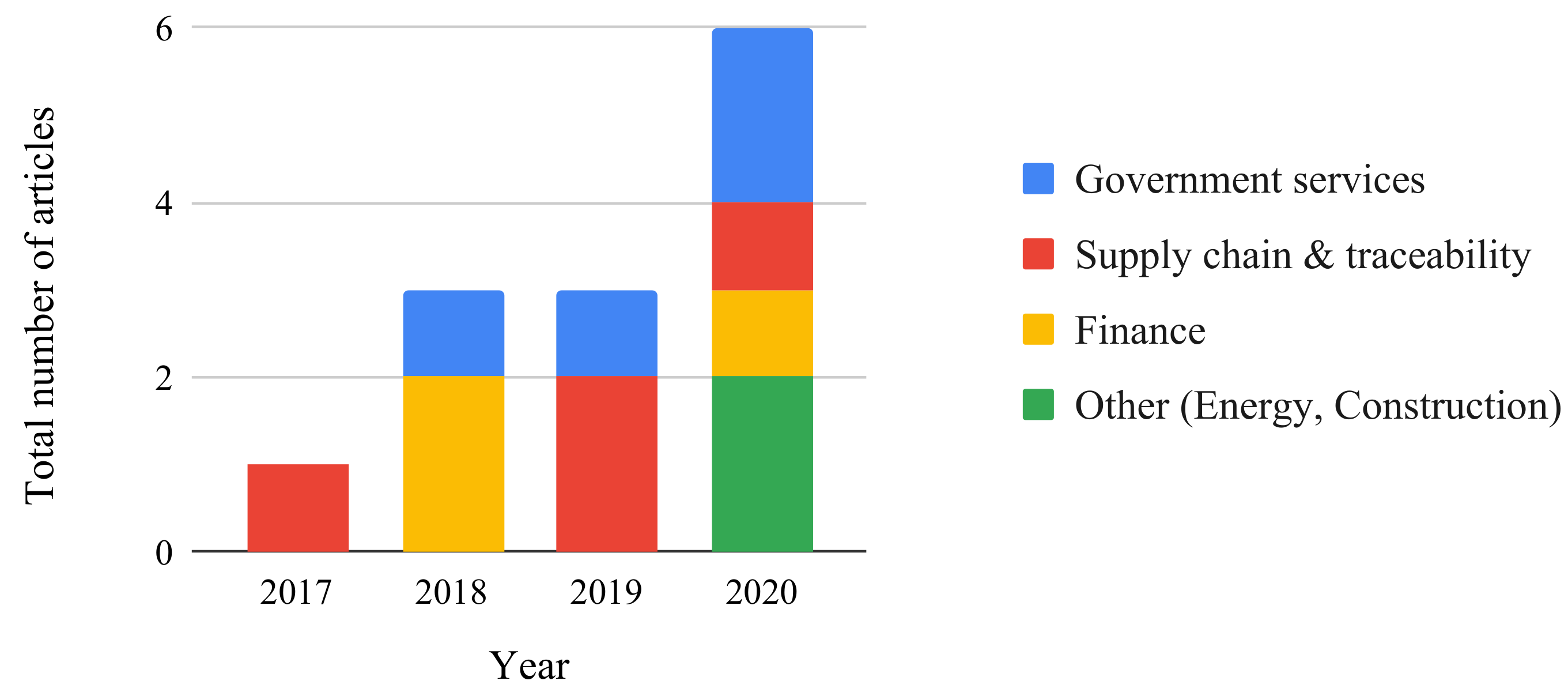
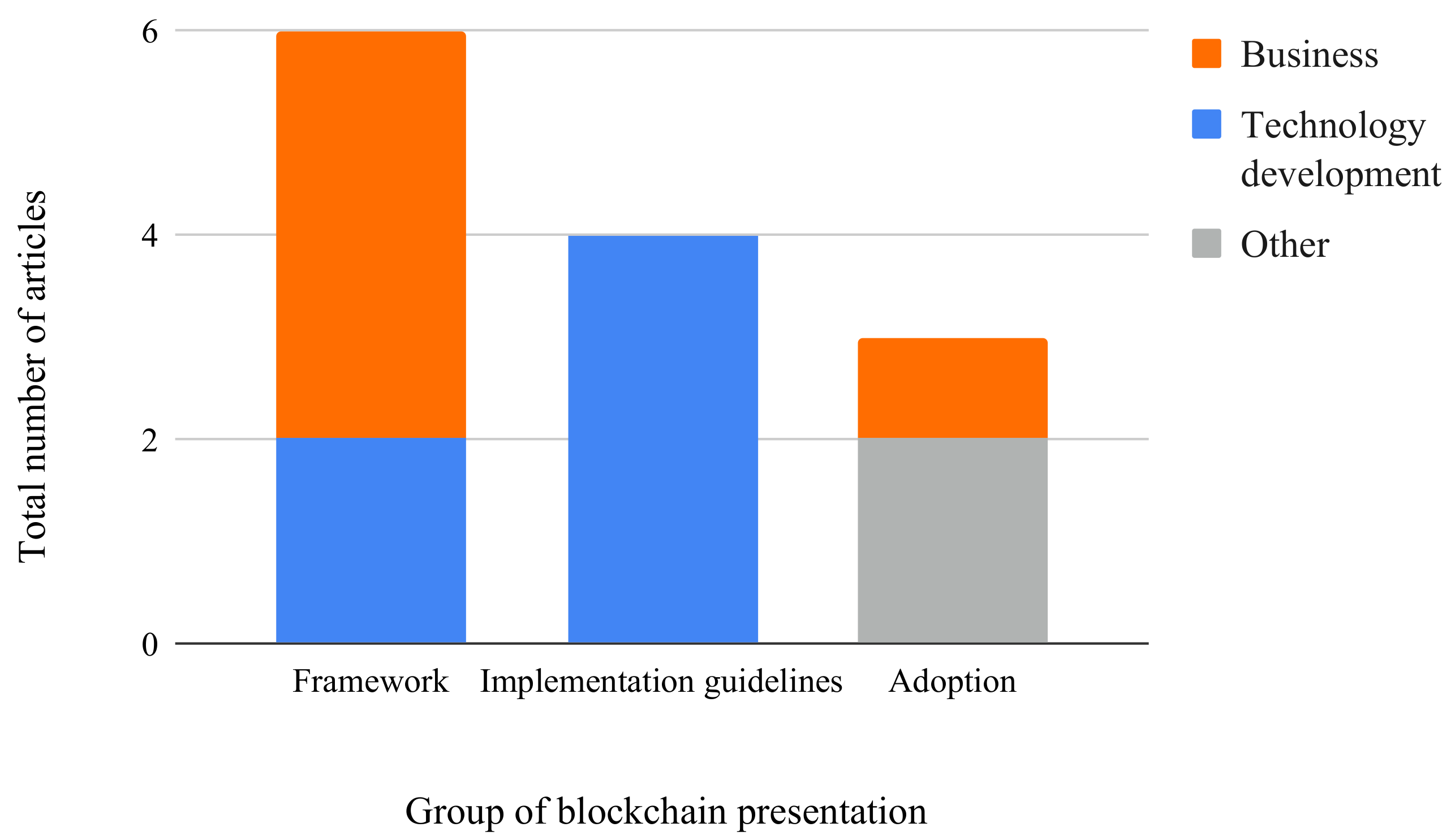

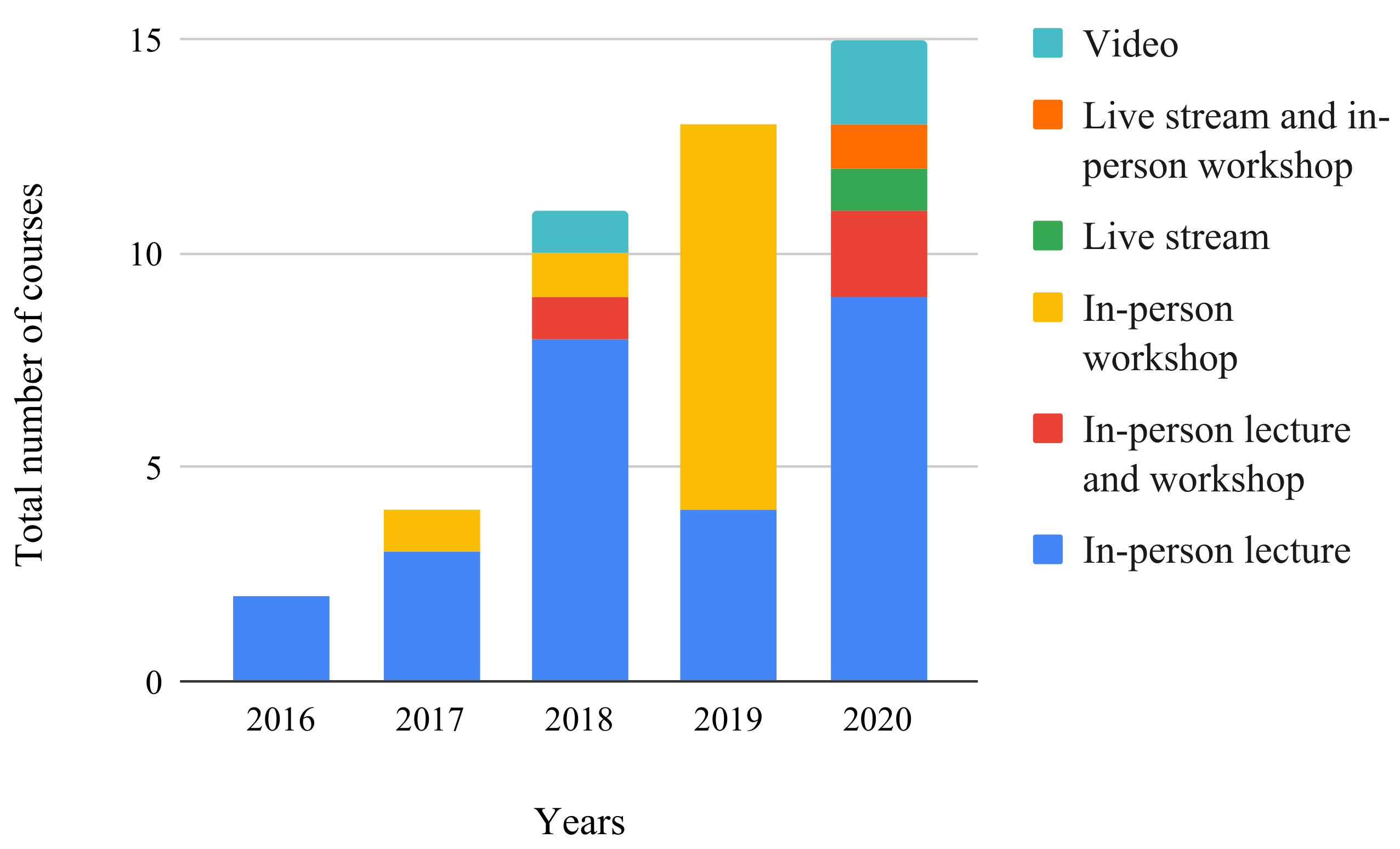
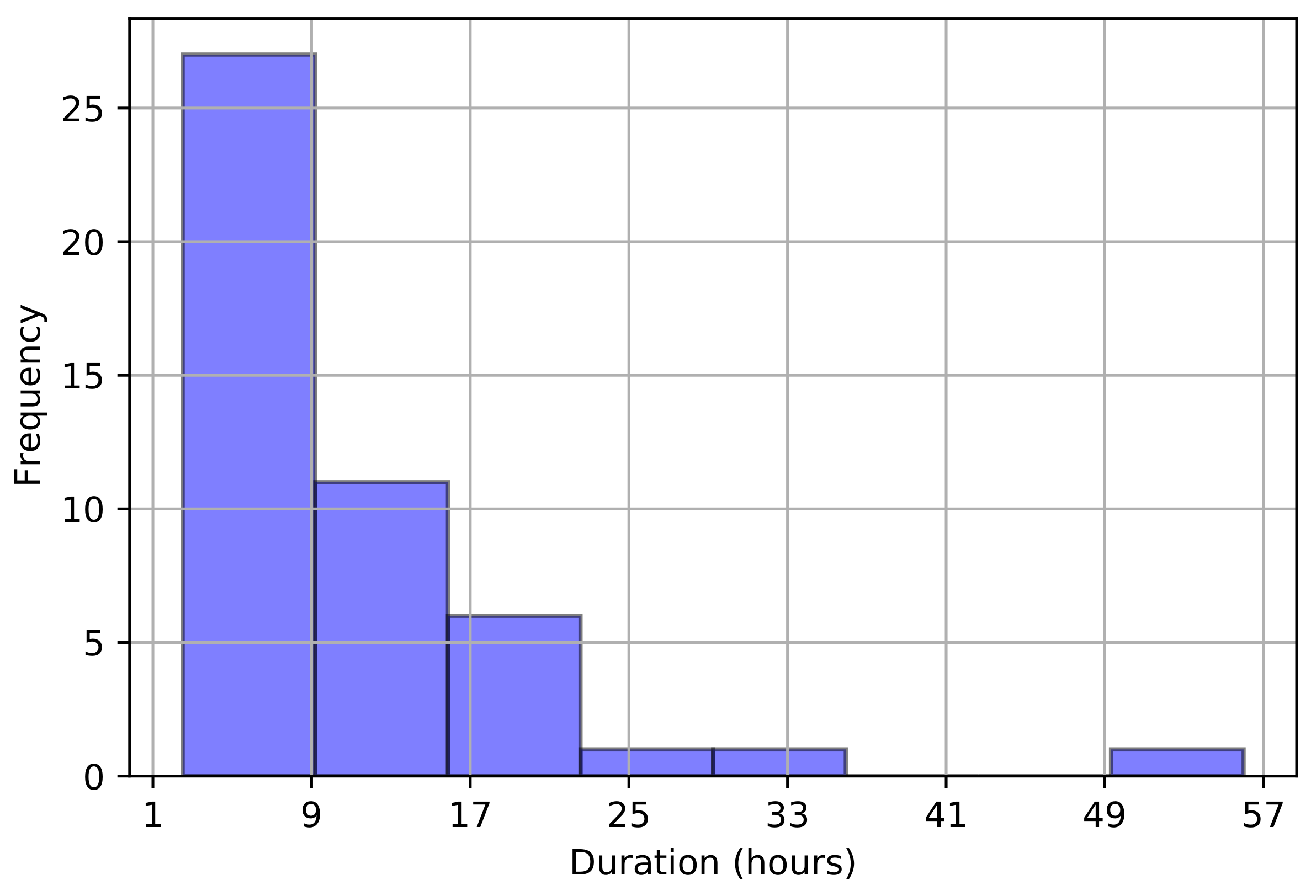
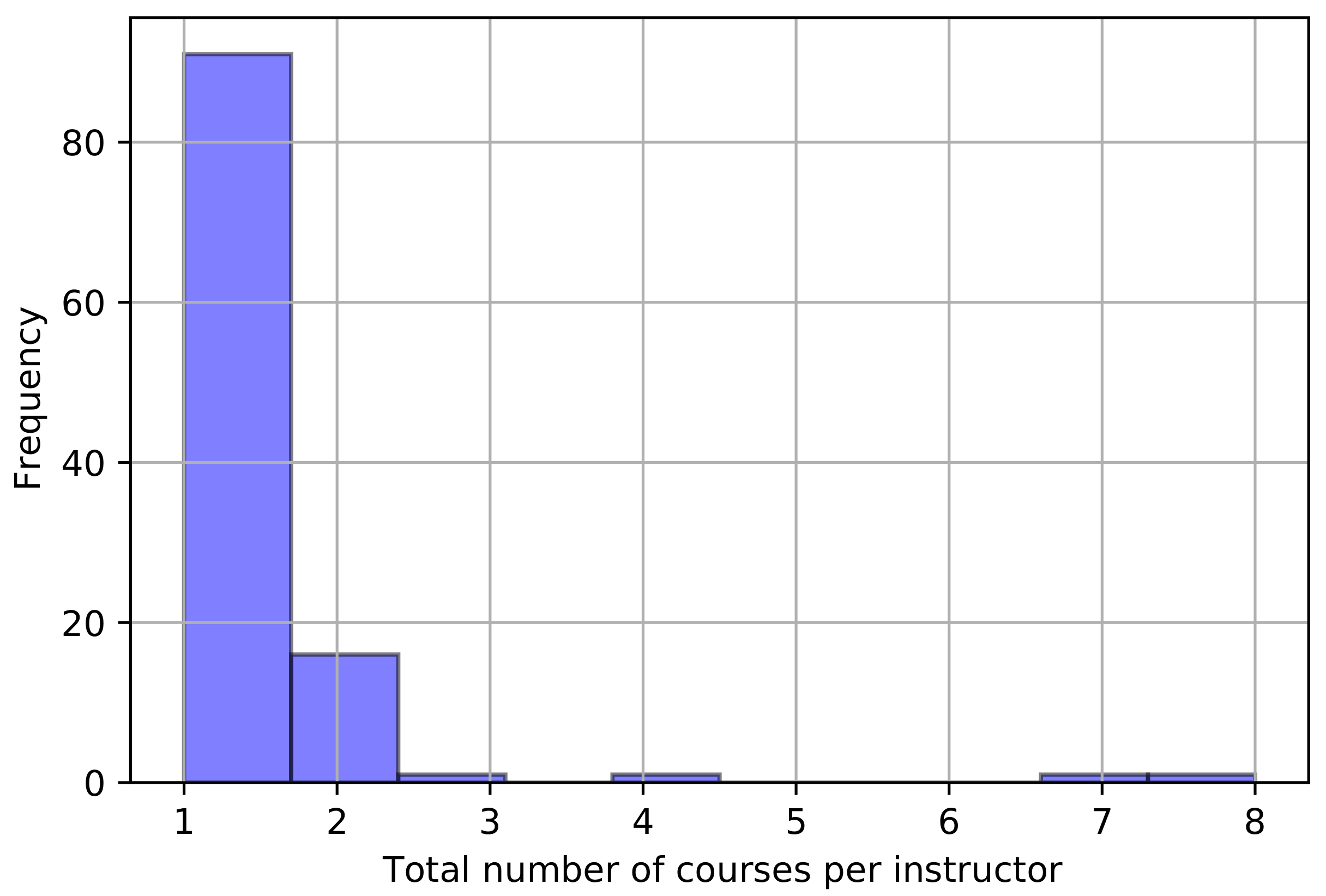
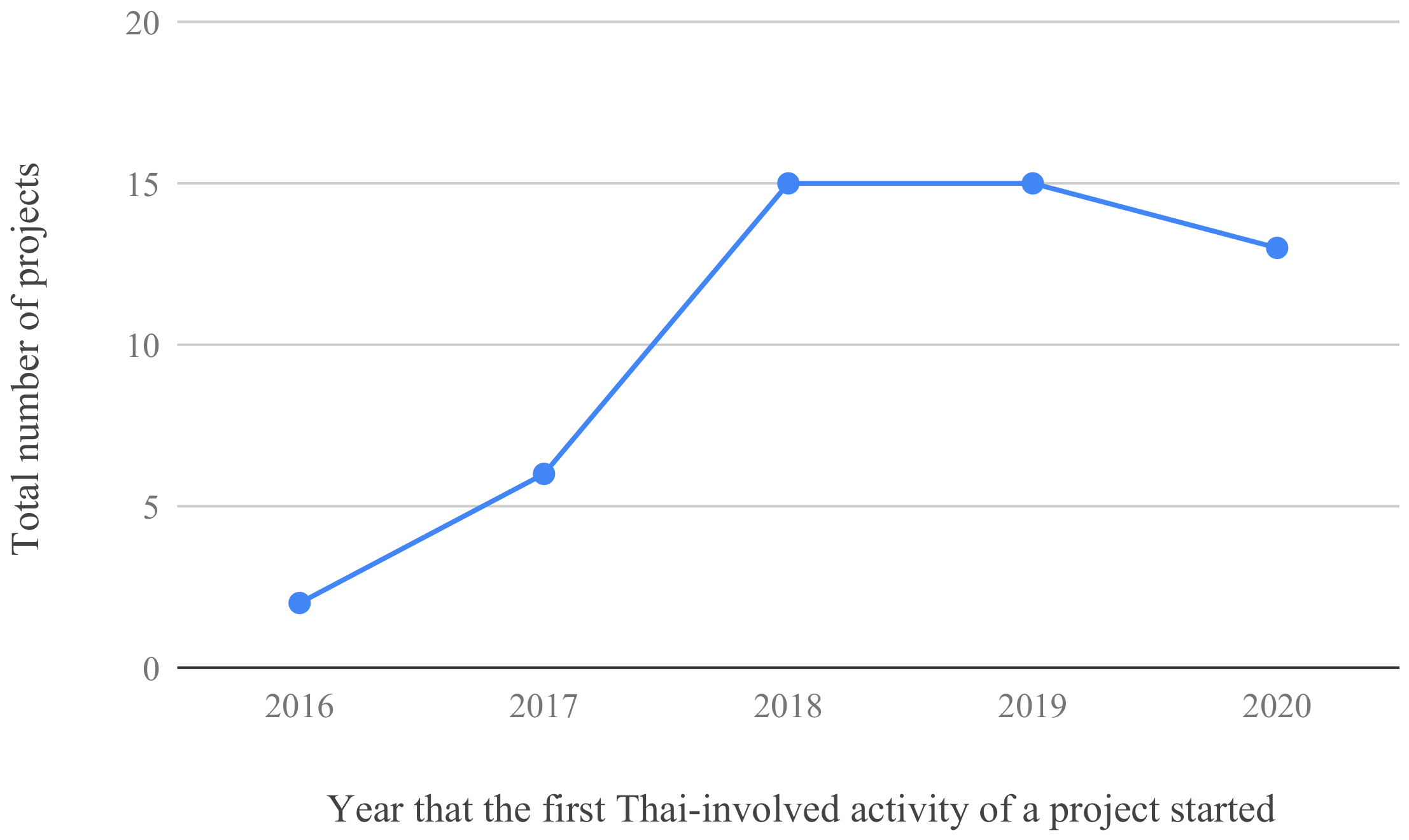
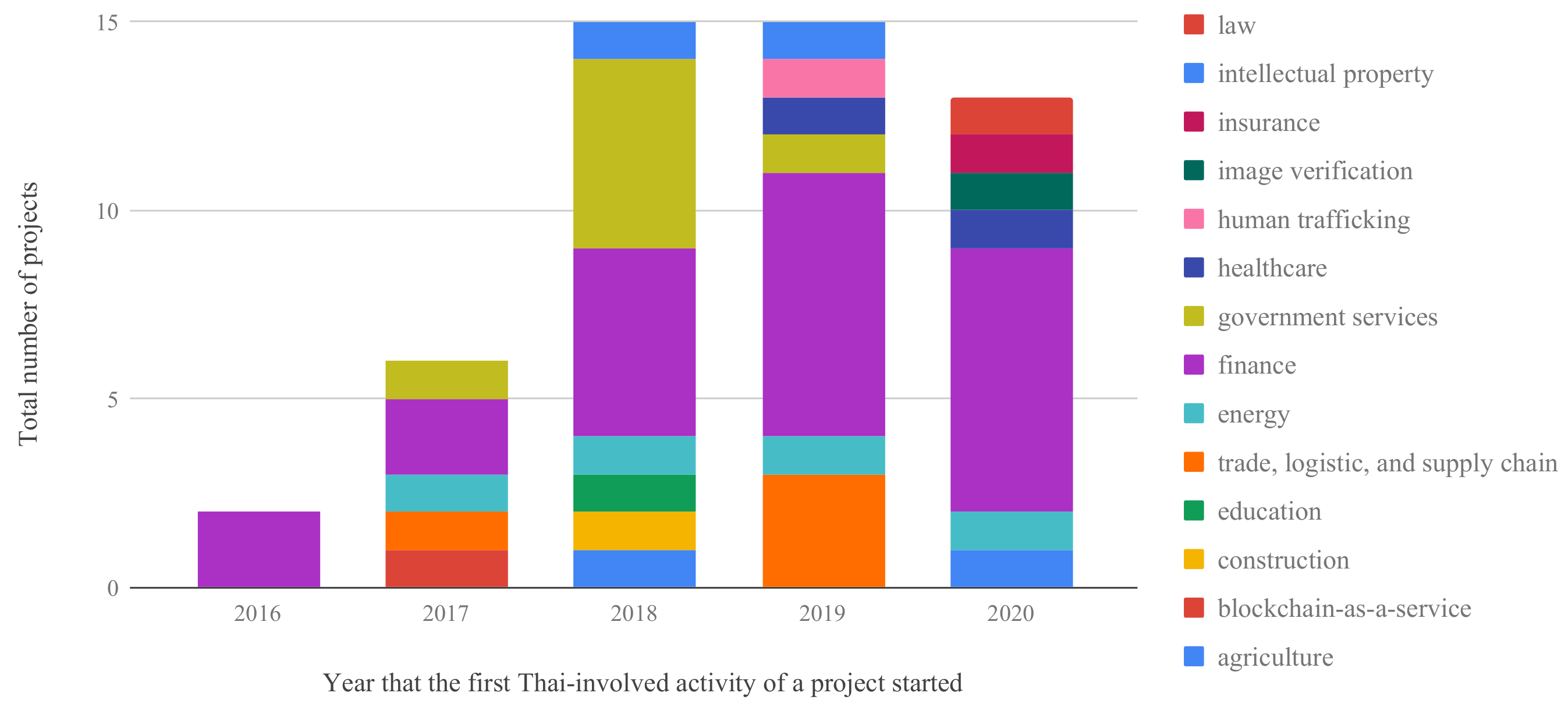
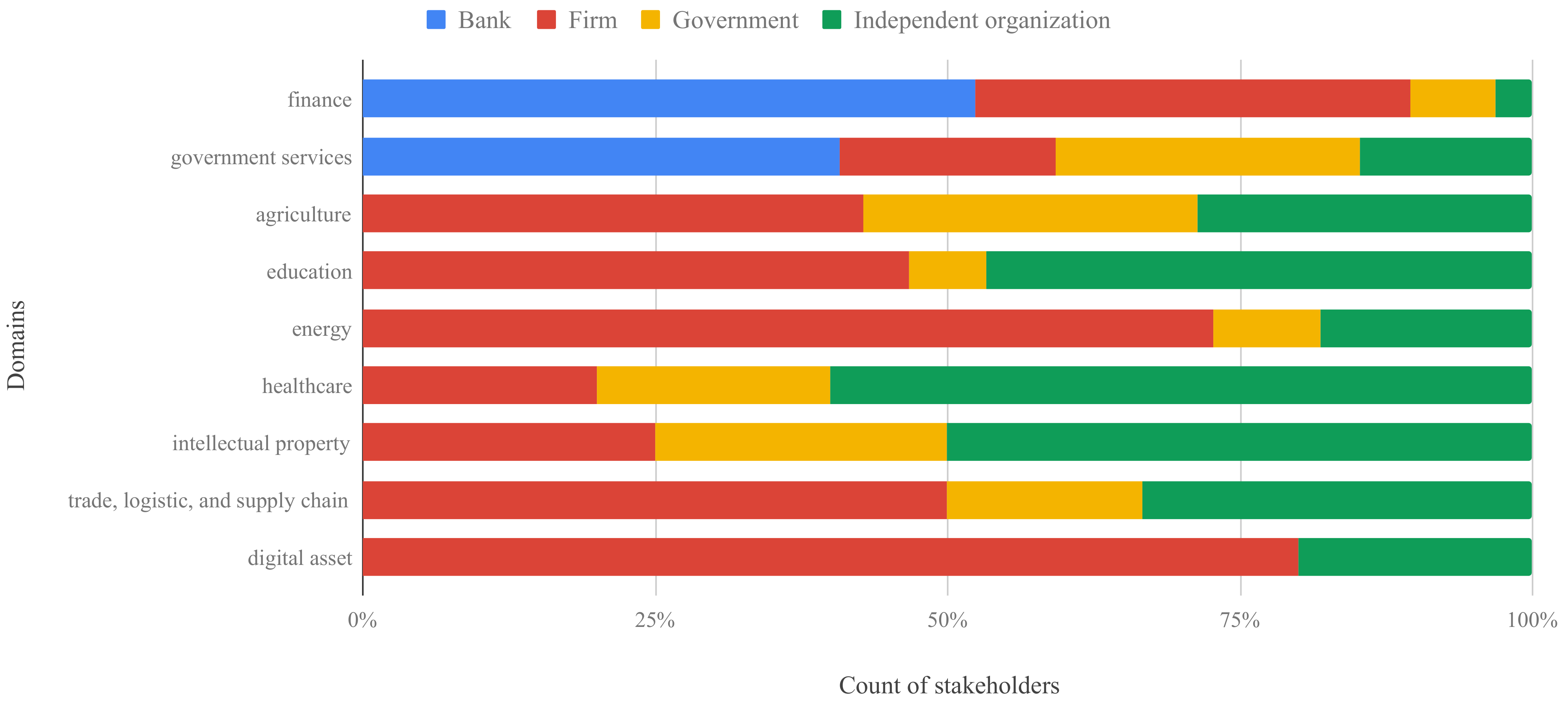
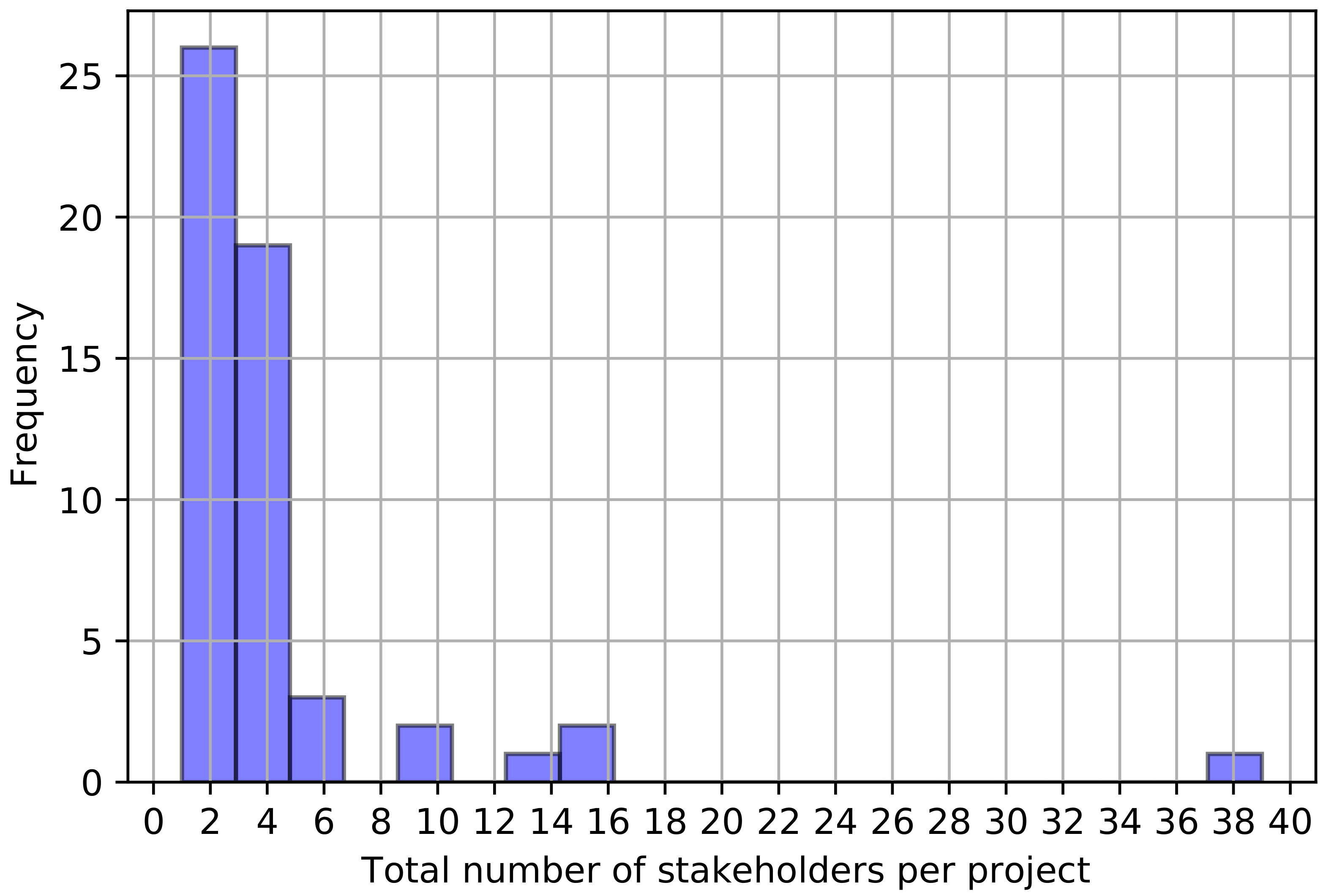
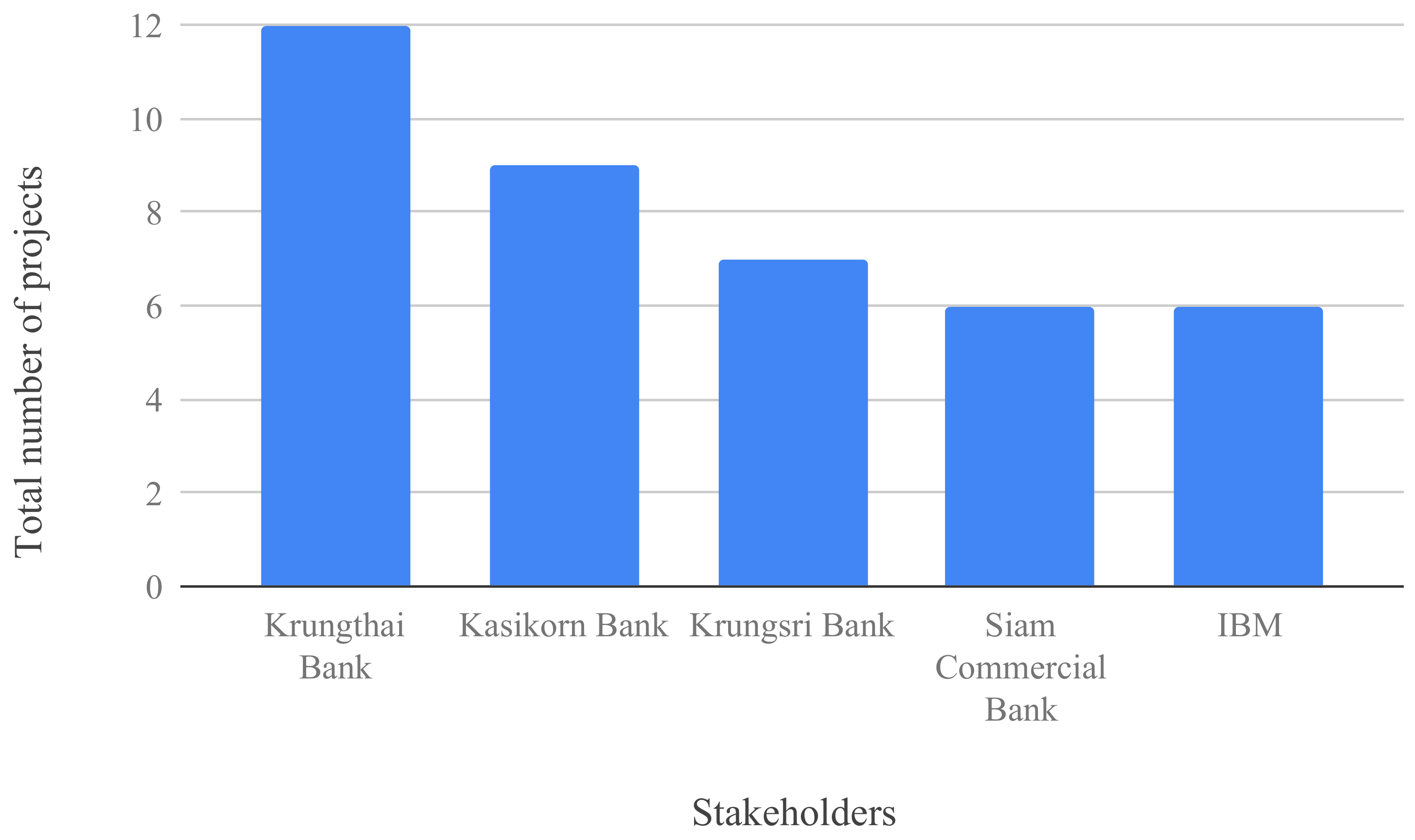
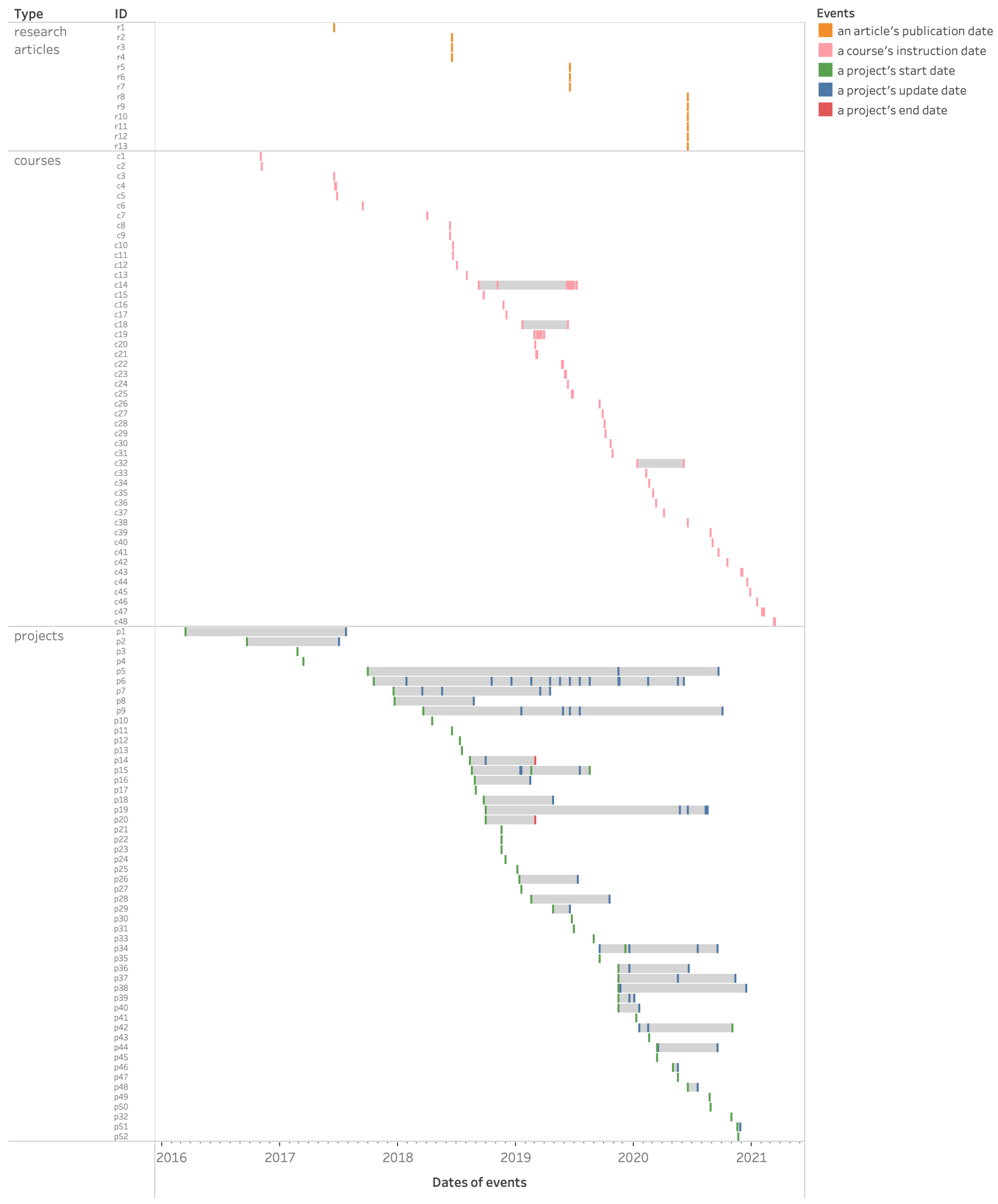
| Selection Criteria | Research Articles | Projects | Courses |
|---|---|---|---|
| Inclusion criteria |
(1. At least one author is Thai OR 2. Having a field research in Thailand) AND 3. Contents of the articles mainly present about blockchain, such as its development, its acceptance, an application of digital currency, etc. |
1. A project must have Thai people exposed to blockchain AND 2. A search result needs to show how blockchain can be applied in a particular industry either in theory or as a launched project AND 3. The data sources should be trustable or supported by experts. |
1. A course must be organized by Thais. AND 2. A course could be a course, a workshop, or a seminar. AND 3. A search result has to show the basic details of courses about blockchain like titles, objectives, and organizers AND 4. The data sources should be trustable or supported by experts. |
| Exclusion criteria |
1. No Thais involved in research OR 2. Research was not conducted in Thailand (excluding publishing) OR 3. Research used data in Thai, but Thais were not exposed to it OR 4. An article was found as a article listing page of a proceeding |
1. The content must not be a duplicate. OR 2. The content is not just a general idea of blockchain |
1. The content must not be a duplicate. OR 2. The content must not provide only materials about blockchain, such as books and articles |
| Domains | Sub-Domains | Article Titles |
|---|---|---|
| Government services | Government services |
|
| Supply chain & traceability | Supply chain |
|
| Traceability |
| |
| Finance | Accounting |
|
| Cryptocurrency |
| |
| Other (Energy, Construction) | Energy |
|
| Construction |
|
| Group of Objectives | Number of Courses |
|---|---|
| 1. Understand the change of business models | 25 |
| 2. Improve software programming skills related to blockchain softwares such as Ethereum, Hyperledger, etc. | 17 |
| 3. Understand a concept of blockchain | 45 |
| 4. Understand cryptocurrency and related topics | 26 |
| 5. Understand ways to trade in cryptocurrency market and ways to run a business related to cryptocurrency | 22 |
| 6. Share experiences about blockchain and cryptocurrency | 16 |
| Course Titles | Objectives | Durations | Target Participants |
|---|---|---|---|
| An example of a short course: | |||
| Blockchain and Bitcoin 101 [32,33,34] (7 March 2020 12:30–18:00) | to understand blockchain technology in details
| 5.5 h. | For a beginner who is interested in blockchain technology, bitcoin investment, and cryptocurrency |
| An example of a medium-length course: | |||
| “Blockchain: The Next Internet?”: A workshop to get to know blockchain technology [35,36,37,38] (19–21 June 2017 9:00–17:00) |
| 24 h. |
|
| An example of a long course: | |||
| “Geeks on the Block (Chain)” A Blockchain Camp for Developers [39] (7 September 2018– 2 November 2018, 7 days of instructions, 8 h per day) |
| 56 h. | For developers who
|
| Domains | Number of Projects | Percentage | Description |
|---|---|---|---|
| Finance | 23 | 42.6 | Actions relating finance e.g., letter of guarantee, letter of confirmation, domestic and international transfer, digital currency, bonds, and gold investment |
| Government services | 8 | 14.8 | Services delivered by a government e.g., tax refund, procurement, fee payment, NDID, identity verification, and voting |
| Trade, Logistic, Supply chain | 4 | 7.4 | Trade, logistics, procurement in supply chain industry, and financial transactions relating to trading |
| Energy | 4 | 7.4 | An exchange or trade of energy including an issue of renewable energy certificates |
| Healthcare | 3 | 5.6 | Medical information management such as medical history |
| Intellectual property | 2 | 3.7 | Intellectual property management including registration, copyright infringement protection, etc. |
| Agriculture | 2 | 3.7 | Agricultural traceability and commerce |
| Law | 1 | 1.9 | Applications relating to law such as case law management |
| Insurance | 1 | 1.9 | Applications relating to insurance |
| Image verification | 1 | 1.9 | Image storage and fraud detection of images |
| Human trafficking | 1 | 1.9 | Applications in human trafficking |
| Education | 1 | 1.9 | Applications for educational purposes such as educational document verification |
| Digital asset | 1 | 1.9 | Actions relating to digital assets |
| Construction | 1 | 1.9 | Applications in construction |
| Blockchain-as-a-service | 1 | 1.9 | A service that provides ready-to-use blockchain platform for users, not relevant to blockchain architecture design |
| Events | Descriptions |
|---|---|
| an article’s publication date | The publication date of the research article. |
| a course’s instruction dates | The dates that instructions occur. Some courses were one-day, while some spanned multiple consecutive dates. Some courses were in a series, offering the same lectures or workshops multiple times. In virtual courses, the dates are the announcement of the courses. |
| a project’s start date | The first date of the project. Due to the incomplete information, this date could be the first time that a project was initiated. If the beginning of the project was not mentioned, the opening ceremony or the first press release will be considered. - Otherwise, the first time that a project was on the press will be used. |
| a project’s updated date | A date that the project’s information was updated to the public. This could be the date when an article was published, when an event was set up to show project’s progress, or when a project that was mentioned in other project’s articles. |
| a project’s end date | The mark of the end of a project. A project could be announced success and conclude with a report. |
Publisher’s Note: MDPI stays neutral with regard to jurisdictional claims in published maps and institutional affiliations. |
© 2021 by the authors. Licensee MDPI, Basel, Switzerland. This article is an open access article distributed under the terms and conditions of the Creative Commons Attribution (CC BY) license (https://creativecommons.org/licenses/by/4.0/).
Share and Cite
Pongnumkul, S.; Bunditlurdruk, T.; Chaovalit, P.; Tharatipyakul, A. A Cross-Sectional Review of Blockchain in Thailand: Research Literature, Education Courses, and Industry Projects. Appl. Sci. 2021, 11, 4928. https://doi.org/10.3390/app11114928
Pongnumkul S, Bunditlurdruk T, Chaovalit P, Tharatipyakul A. A Cross-Sectional Review of Blockchain in Thailand: Research Literature, Education Courses, and Industry Projects. Applied Sciences. 2021; 11(11):4928. https://doi.org/10.3390/app11114928
Chicago/Turabian StylePongnumkul, Suporn, Thachaparn Bunditlurdruk, Pimwadee Chaovalit, and Atima Tharatipyakul. 2021. "A Cross-Sectional Review of Blockchain in Thailand: Research Literature, Education Courses, and Industry Projects" Applied Sciences 11, no. 11: 4928. https://doi.org/10.3390/app11114928
APA StylePongnumkul, S., Bunditlurdruk, T., Chaovalit, P., & Tharatipyakul, A. (2021). A Cross-Sectional Review of Blockchain in Thailand: Research Literature, Education Courses, and Industry Projects. Applied Sciences, 11(11), 4928. https://doi.org/10.3390/app11114928






